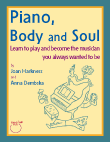
Information for teachers about Piano, Body and Soul
Essential elements of the method
Pianistic gestures (called the pianodance) are combined with interval reading to make musical sounds right from the start. This technique also minimizes the difficulty of reading and playing two staves together.
Free, modal, and blues improvisations encourage attentive listening—to oneself, to other players, and to ambient sounds.
Twelve duets (one piano/four hands) provide valuable experience in ensemble playing, demanding cooperative musicianship as well as “just staying together.”
Unique to Piano, Body and Soul are “grooves,” which offer a contemporary alternative to technique exercises, as well as training for improvisational, pop, jazz, and worldbeat ensemble playing.
Intervals, scales, the overtone series, modes, basic chord progressions, and rhythm training based on You’ve Got Rhythm: Read Music Better by Feeling the Beat seamlessly integrate music theory into technique, improvisation, grooves, and repertoire.
Intriguing newly-composed pieces, as well as classics by J.C. Bach, Rebikov, and Stravinsky specifically address technical playing issues as they arise.
Does this method work in a group class or piano lab?
Yes! Joan's adult classes at the piano lab at the 92nd Street Y in New York City loved this method. To get the most out of Piano, Body and Soul, your students should be encouraged to play on real pianos as much as possible outside of class or lesson time. And because there is such a strong focus on technique, teachers need to pay more attention to how everyone is playing, not just how it sounds through the headphones.
Excerpts from Piano, Body and Soul
Click here to see excerpts from the book.
sign up for our mailing list to hear about new developments from Flying Leap Music.
